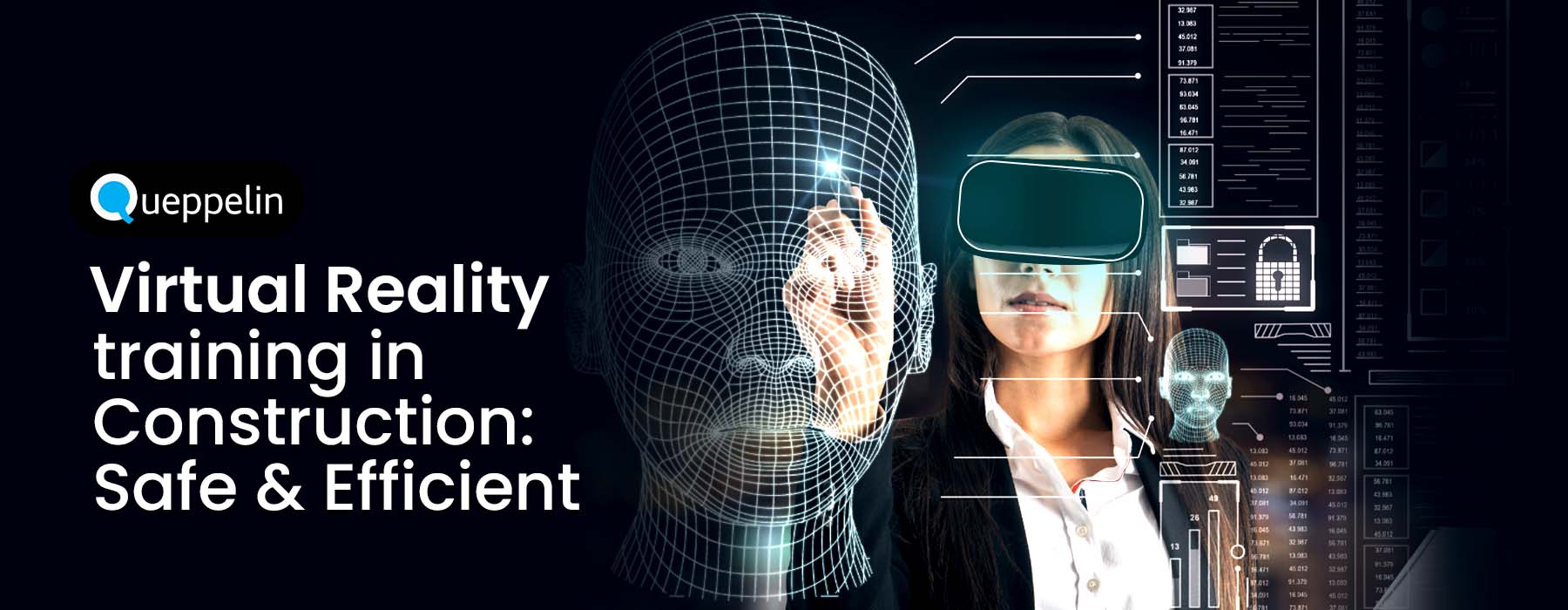Easing the Safety Burden with Higher Workforce Efficiency: VR and AI for Construction Industry
The construction industry is no stranger to unique challenges when it comes to training and skill development. With its dynamic and high-risk nature, traditional training methods often fall short in adequately preparing workers for the complexities they may encounter on the job. However, a game-changing solution has emerged, poised to revolutionize construction training: Virtual Reality (VR) combined with the power of Artificial Intelligence (AI).
In this blog, we will explore the remarkable potential of VR training in addressing the obstacles faced by the construction industry. We will delve into how VR’s immersive simulations can provide an unparalleled learning experience, enabling workers to acquire essential skills in a safe and controlled environment. Moreover, we will examine the pivotal role that AI plays in enhancing VR training, from adaptive learning to intelligent feedback, propelling construction training to new heights of effectiveness and efficiency.
Join us as we embark on a journey to understand how VR training, with the infusion of AI technologies, is reshaping the way construction workers learn, empowering them to overcome challenges and excel in their roles.
Building Brilliance: Unleashing the Potential of Virtual Reality in Construction Training
Through immersive simulations, VR training equips construction workers with crucial skills, improves safety, and enhances efficiency. It helps businesses develop a highly skilled workforce, reduced accidents and mishaps, and more importantly save cost and time on various fronts. Here, we discuss the benefits of VR training for construction businesses.
VR Training Improves Safety and Reduces Accidents: A major concern in the Construction
The construction industry is regarded as one of the hazardous occupations and there are genuine reasons for it.
A normal working day for a construction worker involves working at significant heights like those of skyscrapers, operating heavy and powerful machinery, and working around natural forces such as electricity, water and winds, and whatnot.
In many of these situations, the slightest neglect by the worker may lead to severe injuries or even fatalities. Not to mention the secondary damages in the form of lawsuits and other penalties imposed by authorities.
Hence ensuring safety is one of the most important responsibilities of the decision-makers in the construction industry and VR offers a great help in this regard.
The immersive VR environment places them in the situations and conditions that they would encounter while on the job but in a controlled manner. This way, trainees get a free hand in learning leading to their better understanding of the safety precaution while learning from their mistakes which unlike the real world will not prove costly.
VR Training for Experiential Learning: Better Performance, Higher Confidence, and Lesser Attrition
As VR training allows construction employees to learn by doing them in digital scenarios along the lines of the real world. This is known as experiential learning and it is the most effective way of learning and training.
Experiential learning leads to higher retention around 80-90% at a lesser cost. significantly improves their learning and understanding of their roles and responsibilities on the actual job.
The gap between the training curriculum and the actual job narrows down by a significant proportion and the trainee can practice the same task by doing it as many times. So, by the time their training ends, employees become well-versed in their job which leads to higher performance with greater efficiency and speed.
A study by Accenture showed that the VR trainees demonstrated
on average 12 percent higher accuracy and 17 percent faster time to completion than
instructional video participants.
Not only this, VR training leads to employees feeling more attached to their jobs and also improves their confidence by 275% regarding the lesson they learned through VR. As a result the staff attrition rate drops which is a major concern in the construction industry.
VR Training to Save Time and Cost
Deploying VR training helps businesses save costs on various fronts. First, by making workers better understand and implement safety measures thereby enhancing the overall safety of the site. This reduces unforeseen costs such as on-site injuries, incidents of fines, and damaging litigation and facilitates smoother functioning of the construction works.
Second, as found by the PwC, when deployed on the scale, VR training cost 52% lesser than traditional classroom training.
While as per Capgemini, 82% of companies currently implementing AR/VR say the benefits are either meeting or exceeding their expectations.

Where AI Fits in VR Training for Construction Workers and How it Improves it even Further
Further, by combining with AI VR is revolutionizing the way construction workers learn and enhance their skills. AI is capable of simulating realistic scenarios, providing real-time feedback, promoting collaboration, making VR training a safer practice, improving equipment operation, and enhancing construction processes. In many of Queppelin’s projects, we have integrated AI to achieve the best results possible in VR training. Let’s discuss the transformative potential of AI in VR training for construction workers.
Creating Environments with Realistic Behavior for Authentic Safety Training
AI-powered VR training impeccably simulates dangerous scenarios, such as working at heights, operating heavy machinery, or dealing with hazardous materials. While on the one hand, AI makes all these environment components behave realistically for effective and functional training. On the other hand, it monitors workers’ actions and provides real-time feedback on safety protocols, helping them learn and practice proper safety procedures in a controlled environment.
Realistic Heavy Equipment Operation Training:
To train for heavy machinery operations such as cranes, excavators, or forklifts, AI infuses realistic behavior in the virtual simulation of these real-world machinery. These virtual counterparts immaculately mimic their real-world counterpart to the highest accuracy.
For best heavy machinery training, AI analyzes trainees’ performance and provides guidance on optimal techniques, safe practices, and troubleshooting. This allows workers to gain hands-on experience with different machinery, improving their skills without the need for physical equipment.
For End-to-End Construction Processes Workflow Understanding:
AI simulates various construction processes, including building structures, laying foundations, or installing systems. While VR environments recreate realistic construction sites, allowing workers to practice tasks and workflows in a virtual setting, AI provides feedback on efficiency, accuracy, and adherence to industry standards. Thereby, both VR and AI help workers understand the complete workflow of the process and optimize their work methods.
Collaboration and Communication: AI for Soft-Skills Training
Construction projects involve teamwork and coordination. AI-powered VR training simulates collaborative scenarios, where workers interact with virtual teammates or supervisors. AI analyzes communication patterns, teamwork effectiveness, and problem-solving abilities, offering insights and suggestions for improvement in their inter-personnel skills, communication skills, team handling, dispute resolution, and much more.
For better Site Planning and Robust Design
AI also assists construction workers in the planning and designing phases of the projects. With AI, they can analyze architectural plans, identify potential issues or conflicts, and propose solutions. Then, VR can be used to visualize the proposed designs in a realistic manner, allowing workers to evaluate and provide feedback before the physical construction begins.
Queppelin VR Training Solutions for all Construction Business needs
Having been in the immersive technology space for several years, working with experts on numerous high-impact projects, Queppelin has developed a name. We are among the top immersive technology companies in the world with over 250 team members and over 600 projects.
All this helps us bring you the most comprehensive VR training solution that covers all the aspect of construction in detail and bring the results you always wanted. Here is the list of our VR training modules for construction workers for your to choose from.
VR Training for Fall Protection
Queppelin’s solution provides construction businesses with VR training to enhance worker safety in elevated work environments like high-rise buildings. Employees can engage in immersive training that simulates fall protection scenarios to train workers on how to effectively use fall protection and other safety equipment while responding to potential fall hazards.
Additionally, businesses can utilize VR training to assess workers’ equipment usage, safety awareness, and compliance levels.
VR Training to Enhancing Safety Awareness
Our VR training solutions also let construction businesses raise and test safety awareness in the workers and create a safer working environment. With our VR training solutions, workers can effectively identify potential safety and health hazards, such as chemical risks and faulty equipment.
Through immersive virtual reality experiences, employees are prompted to apply their knowledge of industry safety standards, enhancing their cognitive skills.
By immersing themselves in a virtual environment, workers are trained to locate and address dangerous health and safety risks proactively or minimize their impact before assistance arrives.
VR Training for Firefighting
Queppelin provides VR Training to equip workers with the necessary skills to effectively manage extinguishers and ensure employee safety during fires. Through diverse virtual fire incident scenes, and replicating day-to-day environments, trainees receive realistic training and guidance on using fire extinguishers to extinguish virtual fires.
Further, The VR fire safety training also allows learners to explore a virtual construction building site and identify common fire hazards. This immersive experience trains for fire protection and prevention in different environments, emphasizes the safe use of construction equipment, and execute the required fire safety measures.
Complementing hazard recognition and housekeeping safety training, Queppelin’s VR training ensures a comprehensive approach to fire safety in construction.
VR Training for Confined Spaces
Queppelin enables workers to learn standard procedures for safer working in confined spaces. This training enhances workers’ ability to identify and manage hazards that can cause accidents during confined space entry.
The VR scenarios involve monitoring and assessing associated risk factors, requesting an attendant to watch, and identifying hazards proactively, ensuring the safety of confined space entry.
VR Training for Lockout/Tagout
Queppelin’s VR training offers detailed Lockout/Tagout (LOTO) simulation enabling workers to effectively identify and mitigate hazards for safe maintenance and service-related activities. With virtual reality (VR), employees can practice LOTO procedures without any real-world risks.
Our VR training includes performance assessment allowing trainees to showcase their understanding and alertness and receive valuable feedback.
VR Forklift Simulator Training
Queppelin’s VR Forklift Simulator training is designed to train for forklift operations. Herein, participants gain practical skills and knowledge for safe and efficient forklift operations, meeting safety standards.
Successful completion leads to a well-trained workforce with higher proficiency to operate the machine efficiently and safely.
Other VR Training Projects by Queppelin
VR Training for Biogas Plants Workers
Queppelin developed a biogas plant installed with all the required machinery. We created a highly detailed model for a real-life experience to run test simulations and train the employees. It helped identify lacunae in the safety measures and training sessions on the safety and maintenance of the plant.
The trainees could interact with this machinery and go through the instructional guidance provided to train themselves on different pieces of machinery. This gave the workers an in-depth understanding of the machinery, its components, and its functionality.
VR Training Program For Solar Panel Installation
We developed a VR training solution for our client who deals in Solar panels and wanted to train their workforce on panel installation. It was an exhaustive training program that followed a step-by-step approach.
From cement-laying to combiner box integration, employees were trained with proper guidance and instructions. Interestingly, we developed a special grip system for an enhanced haptic experience, thereby, closing the gap between training and on-job tasks.
VR Training For Farming & Agricultural Equipment
We developed Virtual Reality Training Program for our clients to train employees on agricultural equipment. The VR simulated real-world agricultural scenarios with various natural phenomena including weather, soil conditions, multiple pieces of machinery, etc.
Components of VR Workforce Training in Construction
VR training in construction or for that matter any other business should be based on the needs and goals of that particular business such as the objective of the training, the level of training required by the worker, financial and temporal resources available for the training, and many other crucial factors. However, there are still certain components of effective VR training that remain constant for all types of training. Let’s have a look at each of them so you get an idea of what to look for in a VR training program.
Immersive Environment:
Good VR training must offer an immersive 3D environment comprising interactive 3D objects so that when the trainees wear the VR headset they are surrounded by the digital environment from all sides. This way the trainee will offer real-world scenario training where they learn by doing it and practice repeatedly.
Planned Script
A planned script is a must for a successful training program. It should be well planned to cover the curriculum in detail and it should comprehensively include trainees’ journey through the program taking into account the different types of trainees, their experience and skills levels, the objective of the training, and that of businesses and all other business requirements.
AI Virtual Instructor
This is another important component that a good training program must include. Virtual instructor, especially one powered with AI goes a long way in improving the efficiency of the training exponentially.
Virtual Instructors bring personalization by helping the trainees on different levels of understanding, experience, and skills. AI-backed virtual assistants offer personalized pieces of advice by analysing the past performance of the trainee and offer them insights and suggestions to improve their performance while giving special attention to the areas they struggle most.
Assessment
The last and most important part is the assessment. A good VR training must assess trainees on the understanding and learning they have gained throughout the session. Frequent assessments keep the worker and the trainers informed on the progress and also help develop plans and necessary changes for the future course of the training process.
Conclusion
In conclusion, Virtual Reality (VR) training has emerged as a game-changer in the construction industry. By leveraging the immersive power of VR technology, construction workers can experience realistic simulations, effectively bridging the gap between theory and practice. From safety training and equipment operation to collaborative teamwork and efficient construction processes, VR training has the potential to revolutionize the way skills are acquired and honed.
Furthermore, the integration of Artificial Intelligence (AI) in VR training enhances its impact even further. AI algorithms provide adaptive learning, personalized feedback, and intelligent guidance, ensuring that each training experience is tailored to the individual needs of workers. This combination of VR and AI offers a comprehensive, engaging, and efficient approach to training, ultimately resulting in safer worksites, improved skills, and enhanced productivity.
As the construction industry embraces the transformative potential of VR training, it opens up a world of opportunities for workers to develop their expertise, overcome challenges, and excel in their roles. By stepping into the virtual realm, construction professionals can unlock their full potential, pushing the boundaries of what they thought possible and shaping the future of construction practices.
In this rapidly evolving field, the fusion of VR and AI will continue to push the envelope of training possibilities, fostering a culture of continuous learning and innovation within the construction industry. With VR training, the construction workforce is equipped with the knowledge and skills they need to build a safer, more efficient, and sustainable future.
So, ready to revolutionize your construction business training with VR and AI? Partner with Queppelin, an industry leader in immersive technology solutions. Contact us today to explore how our expertise can elevate your workforce’s skills, safety, and efficiency to new heights. Together, let’s build a brighter future for the construction industry. Visit queppelin.com to learn more.






